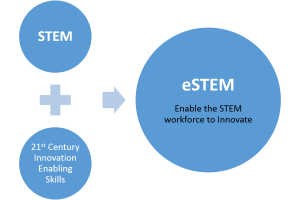How to Engage the STEM Workforce to Innovate ?
The critical need to produce the next generation of the Science, Technology, Engineering and Mathematics (STEM) workforce is now well understood by both the US Government and Corporations, and a number of steps, such as the Next Generation Science Standards, are being taken to rectify this situation. However, The United States 5-year STEM strategic plan, National Science Foundation (NSF), and a number of corporate studies have identified that the Graduate STEM education is at the crossroads and to meet the challenges of the 21st Century, there is a need to engage the newly minted STEM Graduates, and the existing STEM workforce to innovate.
To meet these challenges, there is a need to empower the STEM workforce by teaching them the 21st innovation-enabling skills which are imperative to ensure that they are engaged in the corporate Innovation process. The suggested skills include:
- Enterprise Innovation Management Strategies: The STEM workforce is the cornerstone in implementing these strategies, and they should be aware of (a) corporate innovation strategies and technology knowledge-base, (b) mitigation of the R&D risks, and (c) strategies to successfully transit projects from R&D to the commercial products.
- Emerging Innovation Management Models, Methodologies and Ecosystems: The STEM workforce should understand the broader notion of innovation, including (a) emerging models and their relations to the enterprise innovation practices, (b) emerging Innovation management methodologies, (c) innovation ecosystem components, and (d) global ecosystem models, and leveraging the strength of the U.S.A. innovation ecosystem.
- Venture Science: It is now widely accepted that lack of entrepreneurship skills inhibits the technology transfer and commercialization activities. These skills include: (a) Vision, (b) Bias for Action, (c) Confidence, and (d) Winning Attitude.
- Science of Science Communication: The National Academy of Sciences has identified five goals to promote communication between STEM graduates, public and cross-disciplinary (i.e. Humanities and Social Science) professionals. These goals also support (a) Development of “T-shaped” professionals who can relate to adjoining subject matter experts, and (b) greater integration of disciplines in a project, known as “Team Science”.
- Critical Skills for Personnel Success: The Council of Graduate Schools has identified the critical skills for the Graduate workforce. These skills include (a) professionalism and work ethic, (b) oral and written communication, (c) teamwork and collaboration, (d) critical thinking and problem solving, and (e) ethics and social responsibility. At varying degrees, these skills are normally taught during the K-16 education environments. However, the STEM workforce should be taught the state of art, current knowledge-base, and the best practices to leverage these skills to innovate.
To ensure that the U.S. maintain and enhance its innovation superiority, it is imperative that the government, academia and corporations should incorporate such skills in their STEM workforce development programs.
# # #
